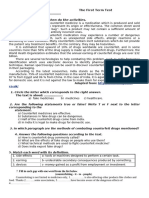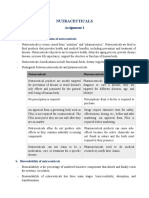Current Challenges and Future Directions of Drug Development
Current Challenges and Future Directions of Drug Development
Uploaded by
Akanksha PatelCopyright:
Available Formats
Current Challenges and Future Directions of Drug Development
Current Challenges and Future Directions of Drug Development
Uploaded by
Akanksha PatelOriginal Title
Copyright
Available Formats
Share this document
Did you find this document useful?
Is this content inappropriate?
Copyright:
Available Formats
Current Challenges and Future Directions of Drug Development
Current Challenges and Future Directions of Drug Development
Uploaded by
Akanksha PatelCopyright:
Available Formats
1
Current Challenges and Future
Directions of Drug Development
Allen Cato
Cato Research Ltd., Durham, North Carolina
Lynda Sutton
Cato Research Ltd., Durham, North Carolina
Allen Cato III
Cato Research Ltd., San Diego, California
It may be easier for a camel to pass through the eye of a needle than it is for a
new chemical entity to reach the marketplace. Drug development is a long and
costly process fraught with tribulation. The tortuous pathway traveled by a new
drug from synthesis to sale requires the constant percolation of data through rigor-
ous clinical and regulatory filters. This process is complex, and success cannot
be guaranteed. The ability to always predict which drug will have all the qualities
necessary to gain regulatory approval and to be marketed remains as elusive as
a camel in a needle’s eye.
New drugs do make it from discovery to the market, but only at the approxi-
mate rate of one in every 10,000 new molecules synthesized. It is a long, costly,
and extremely risky process involving a steady progression through multiple
stages, with treacherous decision points along the way. Most of all, it is a process
involving the constant percolating of data through rigorous filters strewn with
tribulations and complicated by the difficulty of making decisions that affect
human health when all the facts are not known.
Despite the daunting challenge of bringing a new drug from discovery to
market, new medicines continue to be developed that may have a significant
effect on our health. You may wonder, ‘‘What has medicine done for man-
kind lately?’’ In the United States, the adult life expectancy increased by nearly
Copyright 2002 by Marcel Dekker. All Rights Reserved.
30 years over the last century, primarily because of the availability and manage-
ment of vaccines and immunization schedules, antibiotics, and sanitation mea-
sures. As evidenced by the following statistics from the Centers for Disease Con-
trol (CDC) (1), the development of vaccines has had a major impact on our health:
Smallpox killed an average of more than 1500 people per year between
1900 and 1904; it is now eradicated worldwide, and children are no
longer vaccinated against the disease.
Polio struck more than 16,000 people annually in the early 1950s; today,
it has been eliminated from the Western Hemisphere.
During the past 50 years, vaccines also have been responsible for drastically
reducing the morbidity and mortality from measles, Haemophilus influenzae
type b (Hib), diphtheria, pertussis, tetanus (DPT, typically administered together),
hepatitis B, and chicken pox. In addition to improved health, substantial economic
benefits have been realized. For example, the CDC estimates that the United
States recoups its investment in the eradication of smallpox every 26 days. De-
spite the obvious advances of modern medicine, many patients still have infec-
tious, chronic, or genetic diseases and will benefit from the research of today
finding the effective treatments of tomorrow. Pharmaceutical research targeting
the top 12 major medical needs exceeds $645 billion annually in direct medical
expense and lost productivity. The diseases included in this figure are Alzhei-
mer’s disease, arthritis, asthma, cancer, congestive heart failure, coronary heart
disease, depression, diabetes, hypertensive disease, osteoporosis, schizophrenia,
and stroke (2). Just as it did 50 years ago, innovation continues today to bring
us new knowledge through genetic research, molecular biology, and enhanced
computer technology. This is the promising future of drug development.
However, developing the vaccines or any of the drugs potentially used to
treat the indications listed above is a substantial undertaking. To comprehend
clearly the magnitude of the drug-development process, it is useful to consider
the many different areas involved. Figure 1 depicts some of the key disciplines
contributing to the process. Information from each of these areas feeds into a
common funnel with a filter, where multiple decisions must be made progres-
sively regarding the compound’s survival, or lack thereof.
Figures 2 and 3 illustrate the process broken down into preclinical and
clinical segments. Keep in mind, however, that the process is a dynamic one.
The various disciplines listed are constantly interacting, and the entire flow of
data requires constant feedback and fine tuning. For example, a compound’s tox-
icity, however slight, may be considered to outweigh its pharmacological effect.
This information would be given by the toxicologist to the chemist, who would
make other compounds with slight modifications, attempting to retain the pharma-
cological effect while decreasing or eliminating the toxic effect.
Copyright 2002 by Marcel Dekker. All Rights Reserved.
Figure 1 Overall drug development.
Once a compound has been synthesized in the lab and tested in animals,
an Investigational New Drug (IND) application is submitted to the U.S. Food
and Drug Administration (FDA), requesting permission to initiate clinical studies
of the drug in humans. The IND summarizes the preclinical work and includes
the first clinical protocol. It is not until the drug has been experimentally tested
in humans under controlled conditions (after Phase III) that the company may
file an application to market the drug (a New Drug Application [NDA] if filed
with the FDA, or a Marketing Authorization Application [MAA] if filed in Eu-
rope). The application summarizes all preclinical (safety and efficacy in animals),
clinical (safety and efficacy in humans), and manufacturing data known about
the drug, and requests permission to market this new drug.
Figure 4 illustrates the attrition ratio of a new chemical entity as it works
its way from synthesis through preclinical development to IND, and subsequently
through clinical development to NDA. An attrition ratio of 10,000:1 (not consid-
ered good betting odds by most people) is the bad news. The good news is that
95% of all drugs for which an NDA is submitted are ultimately approved for
marketing.
Copyright 2002 by Marcel Dekker. All Rights Reserved.
Figure 2 Preclinical drug development.
The tribulations involved in getting a compound through all the decision
funnels is a costly process, as seen in Fig. 5. The cost per new drug approved
is growing steadily every year. On average, the cost in 1987 was $231 million
per approved drug, but by 1998 that figure had increased to $500 to $600 million
or more (3). As figures demonstrate, the costs are approximately split between
preclinical and clinical development. This average cost represents the expenses
in maintaining a full preclinical and clinical research unit for each new drug
approved. It perhaps makes it easier to understand why large pharmaceutical
companies are sometimes reluctant to pursue development of new drugs likely
to have a sales potential of less than several hundred million dollars per year
(see Chapter 13 on orphan drugs for a more thorough discussion). This reluctance
on the part of large companies leaves opportunities for smaller companies to
develop new drugs with smaller potential earnings. If successful, these smaller
companies may then grow into large pharmaceutical companies and provide addi-
tional treatments that otherwise might have never been made available to patients
in need.
Copyright 2002 by Marcel Dekker. All Rights Reserved.
Figure 3 Clinical drug development.
Drug development is not only a costly process, it is time-consuming as
well (Fig. 6). Although all pharmaceutical companies and many doctors and pa-
tients would like to see the FDA approval times reduced, it is obvious that if
approval times were substantially reduced, it would still require many years for
the development of a new chemical entity. In fact, the average time of review
by the FDA has decreased over the past few years, but the actual time to market
has remained about the same because the clinical development time has increased
(3,4).
The lengthy time required for drug development markedly reduces the pat-
ent life remaining after drug approval for marketing (Table 1). The shrinking
patent protection afforded newly marketed drugs is one reason patent applications
are usually not filed with the first synthesis of a new compound. Pharmacological
and toxicological testing is usually performed before a patent is filed; it usually
takes a year or two before the patent is accepted and officially issued. Therefore,
the remaining patent life is still slightly greater than the original patent life minus
the total developmental time (Fig. 6). The delay in patent filing helps explain
why pharmaceutical companies are somewhat secretive about their preclinical
research process. The danger in delaying filing for a patent is the risk that another
Copyright 2002 by Marcel Dekker. All Rights Reserved.
Figure 4 Attrition rate for overall drug development (average).
Figure 5 Average cost of overall drug development.
Copyright 2002 by Marcel Dekker. All Rights Reserved.
Figure 6 Average time required for overall drug development.
Table 1 Average Effective Patent Life (from NDA approval date)
Patent life without Patent life with
Year extension Waxman-Hatch extension
1966 13.6 years NA
1979 9.5 years NA
1984 9.2 years 11.1 years
1987 10.4 years 12.2 years
1995 7.8 years 11.1 years
NA ⫽ not applicable—before Waxman-Hatch enacted.
Total patent life (from patent approval date) 20 years
Before June 8, 1995 17 years
After June 8, 1995 20 years
Copyright 2002 by Marcel Dekker. All Rights Reserved.
company or individual may discover the same treatment modality and be the first
to file the patent.
Having looked at an overview of the drug development process, it is appro-
priate to explain how the decision filter works. In preclinical testing of a drug,
a toxicological screen is performed with the intent of demonstrating not only a
safe dose, but also the toxic effects. In general, doses of drug that will induce
significant toxicity are administered to animals. Some types of toxicity are more
acceptable than others; for example, if animals were to die unexpectedly and
sporadically throughout several dose ranges without less severe, prodromal pre-
ceding toxicities, administration to humans would be prohibitive. There would
be no way to assure that the same phenomenon (e.g., unexpected death) would
not occur in humans.
How, then, are such judgments made regarding ‘‘acceptable’’ potential tox-
icities? As an example, a great need exists for new antipsychotic compounds.
One such compound was shown to induce lipidosis in the rat after 3 months’
exposure, though no such effects were seen in the dog (Table 2). Lipidosis is the
deposition of fat in cells, and if carried to an extreme, can kill the cell. In particu-
lar, lipidosis-induced vacuoles in the rat were noted in the spleen, liver, and
lymphocytes. Because the anticipated dose in humans was 5–10 mg/kg per day,
this finding in rats at 12–100 mg/kg per day was a cause of concern. The com-
pound looked promising if the lipidosis problem could be solved. To help with
the decision, a review of the literature was performed. As shown in Table 3, only
one marketed compound known to have caused lipidosis in rats also had a similar
effect in humans. Thioridazine (Mellaril), a widely used compound in humans,
was used as a positive control (Table 2). In addition, many other compounds
have been shown to induce lipidosis in rats but not in humans (5). These agents,
like our compound, are mostly for central nervous system diseases. A decision
had to be made to proceed to humans or to stop developing the compound. What
would you do?
The actual decision made in this case was to proceed to clinical trials. The
reasoning was as follows:
Table 2 Preclinical Toxicology (Anticipated dose in humans: 5–10 mg/kg/day)
Dose Time
Species Drug (mg/kg/day) (months) Effect
Rat Inv. drug 12–100 3 Lipidosis
Rat Mellaril 24 3 Lipidosis
Dog Inv. drug 20 3 No effect
Dog Inv. drug 40 3 Increased liver weight
Copyright 2002 by Marcel Dekker. All Rights Reserved.
Table 3 Drugs Known to Induce Lipidosis
Drug Therapeutic action
In animals
Imipramine (Troframil) Antidepressant
Fenfluramine (Pondimin) Anorectic
Thioridazine (Mellaril) Antipsychotic
Chlorcyclizine (Fedrazil) Antihistamine
Zimelidine Antidepressant
In humans and animals
Chloroquine (Plaquenil) Antimalarial
1. Other marketed compounds are known to induce lipidosis and lympho-
cyte vacuolization in laboratory animals, but not in humans.
2. A peripheral marker is available. Although the drug may induce fatty
vacuolization in the liver, a liver biopsy is not needed to detect it be-
cause the process, should it occur, would likely be detected in the lym-
phocytes.
3. The cytoplasmic vacuolization observed in animals was found to be
reversible when the drug was discontinued. Should lipidosis occur dur-
ing clinical trials, subjects or patients should undergo a full recovery
when the drug is discontinued.
The drug was subsequently tested in humans at dosages as high as
500 mg/day for up to 6 weeks. Blood was routinely drawn for careful examination
of the lymphocytes and liver chemistries; no toxic effects were discerned. The
compound ultimately failed the decision filter, however, because of its lack of
efficacy.
I. PHASES OF CLINICAL DRUG DEVELOPMENT
The case described represents just one of many decisions that must be made
before beginning clinical trials. Clinical drug trials are described as Phases I–V.
The first trials in humans that test the drug for safety are considered Phase I.
These studies usually employ normal volunteers, and may expose about 50 indi-
viduals to the drug. For known toxic compounds such as anticancer agents, only
patients with the targeted illness would be used.
The first studies to define efficacy are considered Phase II. These studies
are typically conducted to determine the best dosage regimen for the Phase III
efficacy studies. In general, 100–300 patients would be entered into various con-
Copyright 2002 by Marcel Dekker. All Rights Reserved.
trolled clinical trials during this phase. Phase III, considered an extension of
Phases I and II, exposes a larger number of patients (e.g., 1000–3000) to the test
drug under controlled trials to further delineate the safety and efficacy profile of
the drug. For example, special studies in the pediatric or elderly population may
be performed during Phase III (although the studies themselves may be Phase I-
type studies). After a successful Phase III program, an NDA may be filed with
the appropriate regulatory agency.
Phase IV studies may be done for two different reasons. Marketing-oriented
trials may extend the recommended duration of treatment, or they may be primar-
ily instructive in nature to help familiarize more practitioners with the drug’s
efficacy and side effects. Phase IV trials may be required by the FDA as a condi-
tion of approval to extend the knowledge of the pharmacological effects of a
drug while allowing simultaneous availability to patients. Phase V studies may
extend the indications of a drug to an entirely different disease state. For example,
propranolol (Inderal) was first marketed for the management of angina pectoris
caused by coronary atherosclerosis. Indications were later extended to manage-
ment of hypertension, reduction of mortality after myocardial infarction, ad-
junctive therapy for pheochromocytoma, management of hypertrophic subaortic
stenosis, and prophylaxis of migraine headaches.
II. COMPONENTS OF THE CLINICAL TRIAL
Before discussing some of the problems that can arise during clinical trials, a
brief review of some of the basic components constituting a clinical trial is in
order. Figure 7 illustrates the study periods providing the framework for any
clinical trial.
Prestudy activities include design and setup of the study, and poststudy
activities include data entry, analysis, and report generation. Inclusion and exclu-
sion criteria are determined early in the clinical development process, during the
screening period. Before entry into the study, baseline determinations are made
to which all subsequent changes will be compared. The heart of a trial is the
treatment phase, which consists of drug safety modules and auxiliary modules
(Fig. 8), many of which will repeat measurements made at the time of the initial
screening or baseline. For Phase II and Phase III trials, specific parameters of
efficacy will be assessed. The posttreatment period is the stage at which final
measurements are made for safety; it is also the time to assess the effect of with-
drawal of drug relative to elimination of the disease state or a return toward the
baseline state.
Complex problems reach the decision filter at every stage of drug develop-
ment, even in the early clinical pharmacology phase (Fig. 9). To delineate the
pharmacokinetics of the compound in humans, it is common during Phase I to
Copyright 2002 by Marcel Dekker. All Rights Reserved.
Figure 7 Primary clinical data modules in clinical trials.
Figure 8 Primary clinical data modules in clinical trials.
Copyright 2002 by Marcel Dekker. All Rights Reserved.
Figure 9 Investigational drug development.
measure blood concentrations of the test drug as dosage is increased. Sometimes
the pharmacokinetic data of a study can illuminate problems inherent within the
study. A case in point is the development of a drug in which three similar Phase
III studies were conducted. In one of the studies, no patients in the active group
had measurable concentrations. The placebo group’s samples were then analyzed
and it was discovered that the randomization scheme was reversed for this study.
A second case in point is a Phase I bioequivalence study in which two patients
with similar initials each had a single sample that drastically deviated from their
expected profile. When the concentrations were transposed to each other’s profile,
they seemed to make sense, pharmacokinetically. Reanalysis confirmed the con-
centrations. The Phase I unit, which used bar-coded wristbands, emphatically
denied that there could have been a mixup. A battery of tests was conducted on
the remaining samples and proved that the samples had been switched. Several
pages of the pharmacokinetic report discussed this issue, and, convincingly, the
bioequivalence analysis was then conducted on the samples belonging to the
appropriate subjects. The products were bioequivalent. Without moving the data
to their appropriate places, the products were not bioequivalent.
A final case in point relates a problem that occurred during Phase I testing
of an antidepressant compound. It illustrates that no matter how prepared you
think you are, the unexpected or unanticipated can happen. The incident took
place during a double-blind, placebo-controlled, dosage-titration trial in normal
volunteers. Both plasma and urine samples were being collected for quantitative
analysis of drug levels. Results demonstrated detectable levels of drug in all of
the volunteers at the lowest dosage given. However, at the highest dosage admin-
istered, much to everyone’s surprise, drug was not detected in some of the volun-
teers. Many possible explanations exist, including the following:
Copyright 2002 by Marcel Dekker. All Rights Reserved.
1. The drug is inhibiting its own absorption at higher dosages. Even if
this phenomenon were true, detectable levels should exist in all volun-
teers.
2. The assay was not working properly. The appropriate amount of drug
was recorded from spiked samples randomly distributed throughout
the test samples; this procedure made assay problems less likely.
3. The drug is inducing its own metabolism. Even so, although levels of
drug at higher dosages might be lower, they should not be undetectable.
4. Some volunteers failed to ingest drug. The test site used elaborate pro-
cedures to ensure that volunteers ingested the test drug. This type of
problem was endemic when prisoners were commonly used as volun-
teers. They would swallow the drug, then go to the bathroom and in-
duce vomiting.
5. Placebo and active drug are mixed. Such a situation could arise either
before dosing (packaging error), or after dosing (sampling or labeling
error after blood and urine are collected). If blood and urine specimens
were mislabeled, some instances might occur in which detectable drug
existed in blood but not in urine, or vice versa. In no instance, however,
did this situation occur. Because blood and urine samples were col-
lected from the placebo volunteers to keep the study double-blind,
those specimens were analyzed. In some cases, drug was detected, with
both urine and blood samples correlating positively or negatively. Fi-
nally, drug was analyzed that had been packaged for backup volunteers
in case of dropouts. An absence of drug was demonstrated in some of
the ‘‘active’’ volunteers, and drug was detected in some of the ‘‘pla-
cebo’’ volunteers.
Because an elaborate system of checks and crosschecks was in place to
guard against the possibility of drug mispackaging, it was impossible to think
about such a wholesale mixup. After considerable inquiry, an almost impossible
reason surfaced. A disgruntled employee had deliberately sabotaged the packag-
ing by intentionally mixing drug and placebo.
A packaging error such as the one described is extremely costly. In this
case, the study had to be repeated, with the following consequences:
1. Volunteers had to be reexposed to the test drug and associated proce-
dures.
2. The cost of doing the Phase I trial doubled.
3. The development of the drug was delayed for 3 months.
A new drug can potentially reach sales of hundreds of millions of dollars
in its first year. The ultimate dollar cost of a 3-months’ delay is obvious, in
addition to the fact that patients are denied the use of the drug for 3 months. The
Copyright 2002 by Marcel Dekker. All Rights Reserved.
Figure 10 Investigational drug development.
situation above in the Phase I trial describes a tribulation that can occur at any
point in clinical drug development. However, many issues specific to Phases II
and III also must be anticipated. As seen in Fig. 10, different types of efficacy
studies may be undertaken (see Chapter 6). Special studies, such as tests for
addictive potential or studies allowing compassionate use of the drug (see Chapter
9), occur during these phases.
As already shown in Fig. 8, information regarding safety is collected in
every study. An attempt is always made to determine any adverse events that
may be caused by the drug. The process is especially difficult in patients, because
illness itself is defined by a grouping of adverse events. The critical question
when any adverse event occurs during a clinical trial is, ‘‘Why did it occur?’’
Did the event occur spontaneously, or as a result of an underlying disease, or as
a result of a procedure conducted? Or was it caused by the drug?
What data are needed to answer those questions? Figure 11 depicts points
along the course of a clinical trial at which data must be gathered to make an
assessment. Figure 12 lists some of the numerous information points required
before an accurate judgment can be made.
If Figures 11 and 12 seem unnecessarily complex and unduly detailed rela-
tive to the assessment of causality for an adverse event, consider the study of an
antidepressant. A probe was made at baseline just before initiation of treatment
Copyright 2002 by Marcel Dekker. All Rights Reserved.
Figure 11 Information required for reporting adverse experiences.
(see Fig. 11) to determine the clinical status of the depressed individuals who
were about to enter into the study. As seen in Table 4, an impressive background
of complaints existed before any drug medication. In a 6-week study, multiple
probes will be performed to detect adverse events. Consider, then, if headache
is reported as an episode during treatment (Fig. 11), it will be extremely difficult
to assign causality relative to baseline when more than half the patients reported
headache at baseline.
The symptoms listed in Table 4 afflict all of us from time to time, but
assessments of causality for more serious events should not require the detailed
data reporting depicted in Fig. 12, right? Wrong! Table 5 lists serious adverse
events not present at baseline but occurring during placebo treatment. If these
events had taken place during active therapy, it would have been very difficult
to avoid assigning causality to the drug (see Chapter 14).
Any type of adverse event must then flow through the decision filter. The
tribulations associated with assessing causality can be multiplied if case report
forms (CRFs) are improperly designed. Poorly designed CRFs during Phase II
will compound and multiply the problems encountered in Phase III. Proper design
of CRFs at the start of clinical trials will create a firm foundation for passing
through the multiple decision filters on the way to new drug approval.
A type of tribulation that occurs more in Phase II, and particularly in Phase
III trials, involves adherence to the drug regimen. Drug adherence is loosely
described as the number of dosages actually taken by a patient compared with
the number prescribed. Alas, as with most things in life, further reflection reveals
a far more complex subject. Were dosage administrations properly spaced, were
they taken with meals (if required) or without food (if required), were they taken
with forbidden concomitant medications? With larger Phase III outpatient studies,
the variability of adherence is exaggerated. Adherence is further hindered by
prolonged or complex prescriptions. It can destroy the statistical validity of an
otherwise carefully controlled trial.
Consider the extreme example of a 71-year-old patient who was admitted
to the intensive care unit after being found unconscious at home. Because of his
Copyright 2002 by Marcel Dekker. All Rights Reserved.
Figure 12 Information required for assessing adverse experiences.
Copyright 2002 by Marcel Dekker. All Rights Reserved.
Table 4 Observed Adverse Events at Baseline
Event Percent of patients
Insomnia 92
Tiredness/fatigue 74
Anorexia 59
Headache 54
deteriorating condition, he had been prescribed 13 different medications at one
time or another, but no one had ascertained whether he had adhered to his dosage
regimen. The ambulance staff found 46 bottles containing 10,685 tablets for 13
different medications in his room (6)!
III. THE FUTURE
Although the search for new chemical entities or natural product extracts to treat
diseases is likely to continue for years to come, changes are underway that will
have a profound impact on how we diagnose and treat disease. The identification
of various active entities such as cytokines and delineation of their functions has
already led to a new class of molecular therapies. This process is going to take
a quantum leap forward now that the entire genetic code of a human being is
accessible on the Internet.
One new area generating interest and huge investment is called pharmaco-
genomics—an attempt to identify therapy targeted to an individual’s specific
genetic composition. The desired result would enhance efficacy, or minimize
toxicity, or both. A consequence of deciphering the human genetic code is the
increasing number of blood tests that can reveal disease-gene mutations and pre-
Table 5 Serious Adverse Events
Not Present at Baseline and Occurring
During Therapy with Placebo
Marked EKG changes
Grossly abnormal EEG
Acute renal failure
Seizures
Sudden death
Copyright 2002 by Marcel Dekker. All Rights Reserved.
dict with varying degrees of certainty the chances of progressing to a disease
state. However, with this new technology, new tribulations immediately appear:
Do you want to know that when you are 40 or 50 years of age you may be
diagnosed with Huntington’s disease, a degenerative brain disorder for which no
treatment currently exists?
A huge knowledge gap exists between knowing a gene’s structure and un-
derstanding its function. Some functions are currently known, however, and some
of these genes are the reason for the enthusiasm many hold for gene transfer,
creating a permanent or semipermanent change in the human body. Many tribula-
tions face gene transfer such as getting the gene into a cellular nucleus, having
it express the necessary protein, and having the DNA remain long enough for it
to do its job. Probably the first successes will be with genes that are needed only
for a short time, such as those expressing for angiogenesis. Likely within a few
years (not decades), advanced coronary arterial disease will be treated with gene
coding. Rather than, or perhaps in concert with, coronary arterial bypass grafting,
there will be an ability to grow new vessels to supply oxygen to arterial tissue
that continues to be viable.
Although gene transfer may be the wave of the future, its safety and efficacy
must still be satisfied through the drug development process. Regulatory scrutiny
has already exceeded its previous bounds, but there continue to be areas that can
reduce the time and cost of drug development. Technologically trailing only
slightly behind gene transfer is electronic data capture and real-time data analysis.
Once this technology is implemented, data capture and analysis times for all
studies can be greatly reduced, creating substantial cost savings. The sheer ton-
nage of data required to pass just the clinical decision filter (Fig. 13) is enormous.
If each case report form has an average of 200 data characters, with 25 pages of
CRFs per patient, the total data bits required for a conservatively sized NDA of
2000 patients or volunteers would be 10 million. Information technology will
help manage these data in efficient and less expensive ways.
Figure 13 Quantity of clinical data characters required for an NDA.
Copyright 2002 by Marcel Dekker. All Rights Reserved.
IV. CONCLUSION
Guiding a new chemical entity through the tribulations involved in the drug test-
ing and approval process is a task that is exciting and rewarding as well as long
and complex. Advances in gene transfer, electronic data capture, and real-time
data analysis all promise to increase our chances of success. Ultimately, however,
it is through dedication, skill, and lots of luck that the drug development process
is successful and we can provide a new medication to the people who need it to
fight the pain and suffering of illness. At those times, the camel truly has made
its way home through the eye of a needle.
REFERENCES
1. Impact of vaccines universally recommended for children—United States, 1900–
1999. MMWR Morb Mortal Wkly Rep 1999 Apr 2; 48(12):243–248.
2. The Pharmaceutical Research and Manufacturers of America. Pharmaceutical Indus-
try Profile 2000. Washington DC, 2000.
3. Tufts Center for the Study of Drug Development. Outlook 2000. Boston, 2000.
4. Spilker BA. The drug development and approval process. In: New Medicines in
Development [PhRMA Web site], September 18, 2000. Available at: http:/ /
www.phrma.org/searchcures/newmeds/devapprovprocess.phtml. Accessed October
1, 2000.
5. Lullmann H, Lullmann-Rauch R, Wasserman O. Lipidosis induced by amphiphilic
cationic drugs. Biochem Pharmacol 1978; 27:1103–1108.
6. Smith SE, Stead KC. Non-compliance or misprescribing? Lancet 1974; 1:937.
Copyright 2002 by Marcel Dekker. All Rights Reserved.
You might also like
- The Subtle Art of Not Giving a F*ck: A Counterintuitive Approach to Living a Good LifeFrom EverandThe Subtle Art of Not Giving a F*ck: A Counterintuitive Approach to Living a Good LifeRating: 4 out of 5 stars4/5 (6024)
- The Gifts of Imperfection: Let Go of Who You Think You're Supposed to Be and Embrace Who You AreFrom EverandThe Gifts of Imperfection: Let Go of Who You Think You're Supposed to Be and Embrace Who You AreRating: 4 out of 5 stars4/5 (1133)
- Never Split the Difference: Negotiating As If Your Life Depended On ItFrom EverandNever Split the Difference: Negotiating As If Your Life Depended On ItRating: 4.5 out of 5 stars4.5/5 (911)
- Grit: The Power of Passion and PerseveranceFrom EverandGrit: The Power of Passion and PerseveranceRating: 4 out of 5 stars4/5 (628)
- Hidden Figures: The American Dream and the Untold Story of the Black Women Mathematicians Who Helped Win the Space RaceFrom EverandHidden Figures: The American Dream and the Untold Story of the Black Women Mathematicians Who Helped Win the Space RaceRating: 4 out of 5 stars4/5 (938)
- Shoe Dog: A Memoir by the Creator of NikeFrom EverandShoe Dog: A Memoir by the Creator of NikeRating: 4.5 out of 5 stars4.5/5 (548)
- The Hard Thing About Hard Things: Building a Business When There Are No Easy AnswersFrom EverandThe Hard Thing About Hard Things: Building a Business When There Are No Easy AnswersRating: 4.5 out of 5 stars4.5/5 (359)
- Her Body and Other Parties: StoriesFrom EverandHer Body and Other Parties: StoriesRating: 4 out of 5 stars4/5 (831)
- Elon Musk: Tesla, SpaceX, and the Quest for a Fantastic FutureFrom EverandElon Musk: Tesla, SpaceX, and the Quest for a Fantastic FutureRating: 4.5 out of 5 stars4.5/5 (481)
- The Emperor of All Maladies: A Biography of CancerFrom EverandThe Emperor of All Maladies: A Biography of CancerRating: 4.5 out of 5 stars4.5/5 (275)
- The Yellow House: A Memoir (2019 National Book Award Winner)From EverandThe Yellow House: A Memoir (2019 National Book Award Winner)Rating: 4 out of 5 stars4/5 (99)
- The Little Book of Hygge: Danish Secrets to Happy LivingFrom EverandThe Little Book of Hygge: Danish Secrets to Happy LivingRating: 3.5 out of 5 stars3.5/5 (434)
- Devil in the Grove: Thurgood Marshall, the Groveland Boys, and the Dawn of a New AmericaFrom EverandDevil in the Grove: Thurgood Marshall, the Groveland Boys, and the Dawn of a New AmericaRating: 4.5 out of 5 stars4.5/5 (273)
- The World Is Flat 3.0: A Brief History of the Twenty-first CenturyFrom EverandThe World Is Flat 3.0: A Brief History of the Twenty-first CenturyRating: 3.5 out of 5 stars3.5/5 (2283)
- The Sympathizer: A Novel (Pulitzer Prize for Fiction)From EverandThe Sympathizer: A Novel (Pulitzer Prize for Fiction)Rating: 4.5 out of 5 stars4.5/5 (125)
- A Heartbreaking Work Of Staggering Genius: A Memoir Based on a True StoryFrom EverandA Heartbreaking Work Of Staggering Genius: A Memoir Based on a True StoryRating: 3.5 out of 5 stars3.5/5 (233)
- Team of Rivals: The Political Genius of Abraham LincolnFrom EverandTeam of Rivals: The Political Genius of Abraham LincolnRating: 4.5 out of 5 stars4.5/5 (235)
- On Fire: The (Burning) Case for a Green New DealFrom EverandOn Fire: The (Burning) Case for a Green New DealRating: 4 out of 5 stars4/5 (75)
- The Unwinding: An Inner History of the New AmericaFrom EverandThe Unwinding: An Inner History of the New AmericaRating: 4 out of 5 stars4/5 (45)
- The Synthesis of Lisinopril: OrganicsDocument2 pagesThe Synthesis of Lisinopril: OrganicsAnna Luthfiah100% (1)
- Cleaning ValidationDocument16 pagesCleaning ValidationBabu JadhavNo ratings yet
- Pharmacy Tech Study: Tutorials Top Drugs Exams Forums Misc. ContactDocument8 pagesPharmacy Tech Study: Tutorials Top Drugs Exams Forums Misc. Contactpearl ikebuakuNo ratings yet
- Tabel Daftar ObatDocument15 pagesTabel Daftar ObatEdwin JonatanNo ratings yet
- Case 4 - MCNP - Miguel, Mark Darren, T.Document3 pagesCase 4 - MCNP - Miguel, Mark Darren, T.markNo ratings yet
- Pharm Phlash Pharmacology Flash Cards 1st Edition Leek 2024 scribd downloadDocument71 pagesPharm Phlash Pharmacology Flash Cards 1st Edition Leek 2024 scribd downloadjanosskoog15100% (1)
- Psychoactive DrugsDocument14 pagesPsychoactive DrugsMimi LabindaoNo ratings yet
- Format LplpoDocument9 pagesFormat Lplpositra annaNo ratings yet
- A Counterfeit Drug or A Counterfeit MedicineDocument2 pagesA Counterfeit Drug or A Counterfeit MedicineMoody Candy100% (1)
- Sept. ActiveDocument20 pagesSept. Activeyoginder RathiNo ratings yet
- Boycott v6Document6 pagesBoycott v6Noura AdhamNo ratings yet
- Targeted Drug DeliveryDocument10 pagesTargeted Drug DeliveryYuzak GuntoroNo ratings yet
- Determination of Ibuprpfen in Aqueaus Solutions and PharmaceticalDocument9 pagesDetermination of Ibuprpfen in Aqueaus Solutions and PharmaceticalMaria AlvarezNo ratings yet
- Critical Appraisal of Drug PromotionalDocument41 pagesCritical Appraisal of Drug PromotionalRahul GejjeNo ratings yet
- Chapter 7 IsosteresDocument13 pagesChapter 7 Isosteresمها عقديNo ratings yet
- Nootropil 800Mg Tablets / Piracetam 800Mg Tablets: 1. What Nootropil Tablets Are and What They Are Used ForDocument2 pagesNootropil 800Mg Tablets / Piracetam 800Mg Tablets: 1. What Nootropil Tablets Are and What They Are Used ForSandor SinkaNo ratings yet
- Nutraceuticals: Assignment 1Document10 pagesNutraceuticals: Assignment 1Nguyễn DungNo ratings yet
- COMPLEXATIONDocument55 pagesCOMPLEXATIONRishabh SinghNo ratings yet
- Clean Room Overview Comparison of FDA and EU Regulations: Kumar Gupta Vice President, ParsonsDocument62 pagesClean Room Overview Comparison of FDA and EU Regulations: Kumar Gupta Vice President, Parsonscpkakope100% (1)
- Nifty Replacement IndicesDocument29 pagesNifty Replacement Indicesdileep.jcmNo ratings yet
- Nanoemulgel Activity of Binahong (Anredera Cordifolia (Ten.) Steenis) Leaf - UTS MPB Nomor 4Document8 pagesNanoemulgel Activity of Binahong (Anredera Cordifolia (Ten.) Steenis) Leaf - UTS MPB Nomor 4Robiatul AwwaliyahNo ratings yet
- ISPE Singapore-Disinfectant Validation and Efficacy TestingDocument61 pagesISPE Singapore-Disinfectant Validation and Efficacy TestingBayu Putro WibisonoNo ratings yet
- "Latin Language and Basics of Medical Terminology" CourseDocument7 pages"Latin Language and Basics of Medical Terminology" CourseNataliia LitvinovaNo ratings yet
- Dareoct 19Document6 pagesDareoct 19sppNo ratings yet
- Kerala University of Health Sciences: Bachelor Degree Course in PHARMACY (B.Pharm)Document65 pagesKerala University of Health Sciences: Bachelor Degree Course in PHARMACY (B.Pharm)Mukesh TiwariNo ratings yet
- Compression BasicDocument24 pagesCompression BasicEKA NURUL FALAH 02511740000082100% (1)
- Msc-Medication Administration PolicyDocument42 pagesMsc-Medication Administration PolicyMarianne Laylo100% (1)
- Daftar Obat-Obatan Igd RSKP: Cairan InfusDocument4 pagesDaftar Obat-Obatan Igd RSKP: Cairan InfusMuhamadRifkyFauzyanNo ratings yet
- Med Dose Copyright BNDocument24 pagesMed Dose Copyright BNrookienanayNo ratings yet
- Dokumen PDFDocument29 pagesDokumen PDFYuyunSuciNo ratings yet






































































